HHO Installation Tips and System Wiring
Tips for a safe and great looking installation
Getting a great looking and safe, successful installation for any automotive accessory, HHO systems included, depends to a great deal on how the wiring is done.
In this section we'll look at some hho installation tips that can make a job go easier, safer and look great when it's finished.
Almost all HHO systems will have at least one control or power switch mounted in reach of the driver. To start with, decide what controls you will want within reach of the driver. If it is a single master control switch, look for a place where this switch can be mounted for easy reach. For a custom look, try to find a removable plate or filler panel in the dashboard that you can mount a switch in, such as the one shown in this photo.
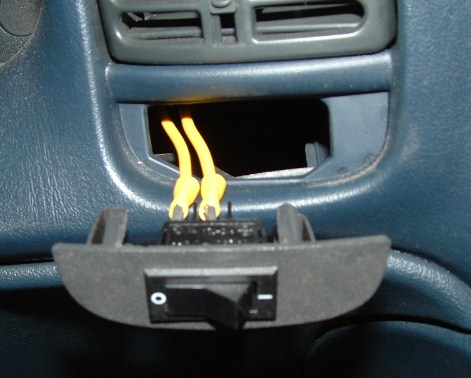
Here we see a plastic filler panel that was removed and cut out to fit the switch. This gives a clean, near-factory look as you can see in this next photo.
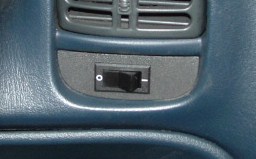 You can use any available area in the dash but try to find one that will be easy to reach safely while driving and easy to mount your controls in. If you can't find a suitable location in the dash itself, you can always make or buy a switch bracket to mount under the dash, these are very common aftermarket add-ons for accessories and are sold in any auto parts store. In this example, a dash filler plate was removed and a rectangular hole cut out to fit the rocker switch. A
Dremel tool
You can use any available area in the dash but try to find one that will be easy to reach safely while driving and easy to mount your controls in. If you can't find a suitable location in the dash itself, you can always make or buy a switch bracket to mount under the dash, these are very common aftermarket add-ons for accessories and are sold in any auto parts store. In this example, a dash filler plate was removed and a rectangular hole cut out to fit the rocker switch. A
Dremel tool is indispensable for this type of work.
is indispensable for this type of work.
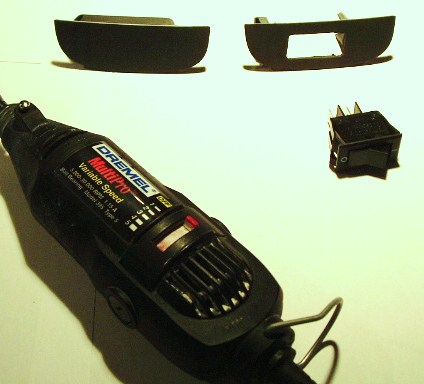
Making a power harness
Most HHO kits will come with at least some wiring. You will still need to find a 12V positive power source. For this, you can make a custom power harness for your particular vehicle. Start by looking for the fuse block, usually located under the dash on the firewall. On most vehicles the fuse block will also have factory accessory terminals. Try to find one that has nothing plugged into it and is hot (with 12V battery voltage) only when the ignition switch is on (very important--DO NOT use a terminal that is hot at all times, you want to make sure your system is not generating HHO when the engine is off). Depending on the type of terminal it is, you may be able to use a standard crimp-on wiring terminal for your harness connector. Even better, try to find a factory pigtail (such as the one shown in this photo with the orange wire)
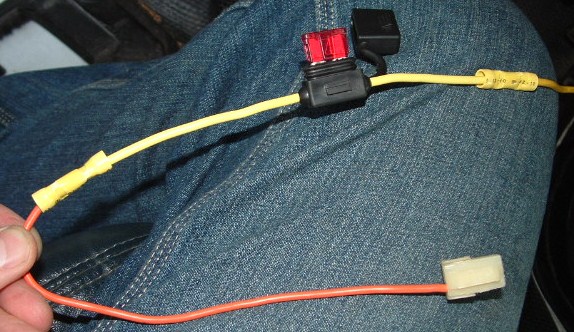 from a wrecking yard car that you can plug into the fuse block. This will lock into place and provide a nice tight connection. Make sure to use at least 12AWG wire.
from a wrecking yard car that you can plug into the fuse block. This will lock into place and provide a nice tight connection. Make sure to use at least 12AWG wire.
Next you will want to add an inline fuse to your power harness. If one was not supplied in your kit, you can pick one up at an auto parts store such as the spade type shown above. The wire should be at least 12AWG (10AWG is better) and the fuse at least a 10 amp. If the kit does not recommend an amperage rating for your system fuse, start with something between 10 and 20 amps. Remember, a fuse is an electrical safety valve so if you are blowing a 20 amp fuse you may be drawing too much power, depending on your system (some higher output systems can draw up to 50 amps or more but these require heavy wire and special safety precautions--check with your kit supplier on these). For most systems, if you are blowing 20A fuses you may need to weaken your electrolyte mixture or you may have a short in your system's wiring.
Some systems use relays and circuit breakers instead of fuses, if your kit's instructions are not clear to you contact the kit supplier and get help before proceeding. If you are installing a system that you know will draw higher amperage, say over 25 amps, you should use a relay instead of direct power to your dash control switch. Once again, follow your kit manufacturer's recommendations on this.
Shielding and routing wire
When running wire through engine compartments and firewalls always use shielding as in this photo.
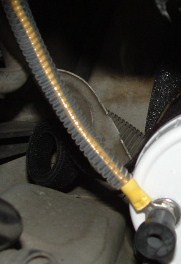 Engine compartments can get quite hot and there are a lot of metal parts which wires can come in contact with. Wires carrying a lot of current such as the ones supplying your HHO system must not be allowed to short to a ground. While the HHO power wires can be tucked into existing factory wire shielding, it is best if they are routed in their own shielding due to the current load. This way, should they overheat they will not damage any other part of the harness.
Engine compartments can get quite hot and there are a lot of metal parts which wires can come in contact with. Wires carrying a lot of current such as the ones supplying your HHO system must not be allowed to short to a ground. While the HHO power wires can be tucked into existing factory wire shielding, it is best if they are routed in their own shielding due to the current load. This way, should they overheat they will not damage any other part of the harness.
Once shielded, wire should be routed along with the vehicle's factory wiring and zip tied together for a clean factory look. This will also keep them from getting caught up in engine parts.







 You can use any available area in the dash but try to find one that will be easy to reach safely while driving and easy to mount your controls in. If you can't find a suitable location in the dash itself, you can always make or buy a switch bracket to mount under the dash, these are very common aftermarket add-ons for accessories and are sold in any auto parts store. In this example, a dash filler plate was removed and a rectangular hole cut out to fit the rocker switch. A
You can use any available area in the dash but try to find one that will be easy to reach safely while driving and easy to mount your controls in. If you can't find a suitable location in the dash itself, you can always make or buy a switch bracket to mount under the dash, these are very common aftermarket add-ons for accessories and are sold in any auto parts store. In this example, a dash filler plate was removed and a rectangular hole cut out to fit the rocker switch. A
 from a wrecking yard car that you can plug into the fuse block. This will lock into place and provide a nice tight connection. Make sure to use at least 12AWG wire.
from a wrecking yard car that you can plug into the fuse block. This will lock into place and provide a nice tight connection. Make sure to use at least 12AWG wire. Engine compartments can get quite hot and there are a lot of metal parts which wires can come in contact with. Wires carrying a lot of current such as the ones supplying your HHO system must not be allowed to short to a ground. While the HHO power wires can be tucked into existing factory wire shielding, it is best if they are routed in their own shielding due to the current load. This way, should they overheat they will not damage any other part of the harness.
Engine compartments can get quite hot and there are a lot of metal parts which wires can come in contact with. Wires carrying a lot of current such as the ones supplying your HHO system must not be allowed to short to a ground. While the HHO power wires can be tucked into existing factory wire shielding, it is best if they are routed in their own shielding due to the current load. This way, should they overheat they will not damage any other part of the harness.